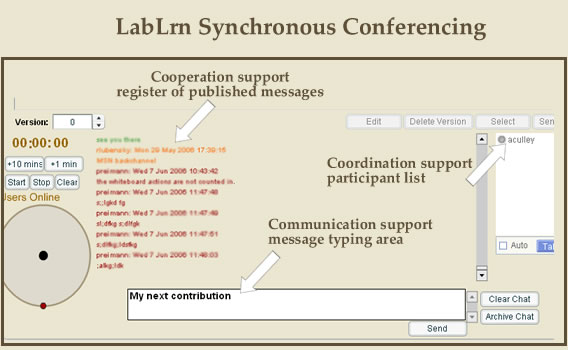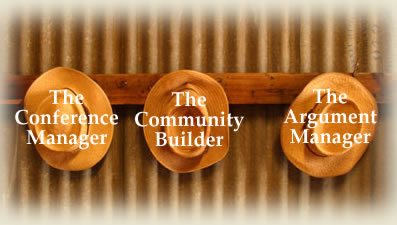Computer Supported Collaborative Learning
Written by Annette Devilee – prepared as part of the assessment for her Master of Learning Science and Technology (MLS&T) at The University of Sydney. 2008.
Design Rationale
Lrnlab is a form of groupware, a term which refers to software that supports collaborative projects. In most groupware “three main components can be identified: an area used to type the message, enabling the user to communicate with other participants (Communication support); a list of participants, indicating who is connected and available for conversation (Coordination support); and an area presenting a record of sent messages (Cooperation support).”(Fuks et al., 2006:5) LrnLab also includes a timer and notes for coordination, session records and notes for cooperation and audio and whiteboard for communication (Fig 1).

Figure 1 was adapted from Fuks et al. (2006:5).
Goodyear et al. (2001, Part 8) make a useful distinction between “Space” and “Place” in a networked learning environment. I also see this distinction as useful in collaborative work. In this project there were two distinct phases: the first being where we worked on our own section and the second being when we, as a group, took ownership of the whole project; each person working on different aspects of the project. If I identify the space as the LrnLab environment and the place as where the individual customises this space then we can say that there was a shift from an “individual place” to a “group place” as the collaborative process evolved. (Fig 2)

A Socio-Cultural Approach
Vygotsky’s Socio-Cultural approach suggests that tools mediate mental functioning and action. In this project the computer mediated our communication, thoughts, writing and action. Working in a small but decentralised group, this project was social, contextualised and situated; we are post-graduate students, working as a team from distant locations, contributing towards one project on the Semantic Web. In CSCL the technology provides affordances that only result in action if the users perceive the affordance and choose to use it. How these affordances are used is determined by us, the users, the context and our situation from week to week.
Even though we organised tasks for each individual, realistically the division was determined by each persons’ interests and capacities. This project required us to work closely together and to rely on each others’ contribution. By doing so we developed a small Community of Practice. We had a “shared enterprise, mutual engagement, and a shared repertoire (Wenger, 1998, p. 72).
An Ethical Perspective
Ethical issues of trust arose at various points through this project. We had to trust that each person would do their part. When someone did not honor that trust, neglected to respond to communication or did not complete a task by the time it was needed, I felt let down. I felt betrayed when someone did not reciprocate in the sharing of resources or in the assistance rendered. “Many challenges and difficulties exist pertaining to the quality and variability in student participation” (Hewitt, 2003; Lipponen, Rahikainen, Lallimo, & Hakkarainen, 2003). Being new to the collaborative process, I had to carefully weigh up the ideas and decisions of the group to my own ideas. There were times when I had to let go of my personal beliefs and other times when I had to stand my ground. Ultimately, I had to put the benefits to the group before self interest. In this sense, a collaborative project based approach helps the student to become aware of ethical issues and to develop social skills for every-day learning.
We all had to accept that each person could only contribute according to their abilities; this varied between the group members. In the communal living of Israeli Kibbutzim, the social philosophy is “From each according to his ability and to each according to his needs”. (K.Marx: Critique of the Gotha Programme). This social model of ethics can be applied to learning. Ben-Sefer (2005) identifies the essential characteristics of this philosophy to include collective responsibility. This ethic provides a “support structure” for the student who needs assistance. It is a philosophy of “caring about and for each other, a social ideal” (Ben-Sefer, 2005). In addition to this general philosophy, Kibbutz education emphasises activity-based instruction and includes group and individual work in an informal setting (Dror, 1999).
Chat Confusion
Any collaborative project relies on clear communication and understanding. Difficulties following or understanding a chat sessions are called “Chat Confusion” (Pimentel, Fuks, & Lucena, 2003; Thirunarayanan, 2000). There are various forms of Chat Confusion. When several threads of conversation are going at the same time making it difficult to determine who is replying to whom, it is referred to as “Co-text Loss”. Co-text loss can be alleviated by using the LrnLab facility to “Reply”. This tags the message to a specific comment. This facility is available when in the Chat room of LrnLab but not in the Notes room. It would have been useful to have the Reply facility in the note area as well as the chat area. When text is coming too fast to keep up with, it is referred to as “Message Overload”. It can be caused by a “flood problem”. Message overload can be alleviated by using some sort of queuing strategy so that everyone gets a chance to “speak”(type) and be “heard”(read).
During our conferences we only used the “free contribution” style of chat where anyone can type at any time. However Fuks et al. (2006:13-14) describe other ways we could have structured the chat. “Circular Contribution” is where each person has a turn to contribute in a particular order, “Single Contribution” is where each person contributes in any order and “Blocked” is when only the moderator can contribute. On reflection, I think the use of circular or single contribution would have encouraged the quieter students to speak up the more verbose members to wait and listen. The use of all these forms of contribution would have given more structure to our conferences. Fuks et al. (2006:15) found that a “well-structured dynamic organises the debate and thereby considerably reduces Chat Confusion.”
Role Taking
The moderator is responsible for setting the agenda, preparing notes and steering the discussion towards the objectives. This included time management, negotiation of tasks and how we collectively would proceed towards action. Although consensus is preferable, if we could not reach agreement a vote was taken.
Pilkington & Walker (2003) investigated a wide range of role taking for synchronous discussion. They found that by raising student awareness of roles there was an improvement of the “overall coherence, focus and depth of discussion” for “some” students. These roles can be useful in collaborative work towards a “jointly negotiated product” (Pilkington & Walker, 2003). They classed these roles into three groups: management roles, community building roles and argumentation roles. The aim of the community building role is to develop trust in the group. This can be done by ensuring that everyone has an “equal chance to speak” and that they are “listening and responding to the contributions of others” (Johnson & Johnson, 1994; Robertson, Good & Pain, 1998; Wegerif & Mercer, 1996). The aim of the argumentation role is to ensure that people explain themselves clearly and if they challenge someone else then they must justify themselves and contribute an alternative solution (Wegerif & Mercer 1996, p. 5).

“Before a community can become a knowledge-building community it is first necessary to establish a “safe space” in which the sharing of knowledge is encouraged and validated (Pilkington & Walker, in press).”
Knowledge Building
Knowledge building has it’s focus on the creation of knowledge (Paavola, Lipponen, & Hakkarainen, 2004, cited in Eddy et al., 2005:59). Eddy et al.(2005:59) define it “as the production and continual improvement of ideas of value to a community.” Collective cognitive responsibility plays an important role in knowledge building. The “goal is to advance the frontiers of knowledge as they perceive them” (Bereiter & Scardamalia, 2003).
Sfard (1998) described two metaphors for learning: “knowledge aquisition” and “learning-as-participation”(Sfard, 1998:4). Knowledge building is considered to be the third metaphor for learning (Eddy et al., 2005:59).
Our collaborative exploration of the Semantic Web produced an instructional text and a lesson on a relatively new field. These products may have problems of truth or validity but I believe we built new knowledge and advanced frontiers in this field. At least we did from our perception; an important aspect of knowledge building.
References
- Ben-Sefer, E. (2005) Kibbutz Nursing: an exemplar of primary health care. Online Journal of Issues in Nursing. Article published December 12, 2005. Retrieved 15 June 2006 from http://www.nursingworld.org/ojin/topic12/tpc12_12.htm
- Bereiter, C. and Scardamalia, M. (2003)Learning to Work Creatively With Knowledge. OISE/University of Toronto Revised: 16 February, 2003 Permission granted to quote. Retrieved 16 June 2006 from http://ikit.org/fulltext/inresslearning.pdf
- Dror, Y. (1999) Progressive Informal Education Interpreted by the Founders of Kibbutz Education in Eretz Israel (Palestine), 1918-1948, Blackwell E-Journal of Education History, Oranim & Haifa University, Israel. Retrieved 15 June 2006 from http://www.cedu.niu.edu/blackwell/dror01.htm
- Eddy Y. C. Lee, E.Y.C., Chan, C.K.K. & van Aalst, J. (2005) Students assessing their own collaborative knowledge building. International Journal of Computer-Supported Collaborative Learning. Issue: Volume 1, Number 1 Date: March 2006 Pages: 57 – 87
- Fuks, H., Pimentel, M. & Pereira de Lucena, C.J. (2006) R-U-Typing-2-Me? Evolving a chat tool to increase understanding in learning activities. International Journal of Computer-Supported Collaborative Learning An Official Publication of the International Society of the Learning Sciences. Volume 1, Number 1 Date: March 2006
- Jones,C. Dirckinck-Holmfeld, L. and Lindström, B. (2006) A relational, indirect, meso-level approach to CSCL design in the next decade. International Journal of Computer-Supported Collaborative Learning Volume 1, Number 1 Date: March 2006
- Pilkington, R.M. & S. Walker, A. (2003) Facilitating debate in networked learning: Reflecting on online synchronous discussion in higher education. Instructional Science 31: 41–63, 2003.
- Sfard, A. (1998) On Two Metaphors of Learning and the Dangers of Choosing Just One. Educational Researcher, Vol 27, No 2, (March 1998), 4-13
